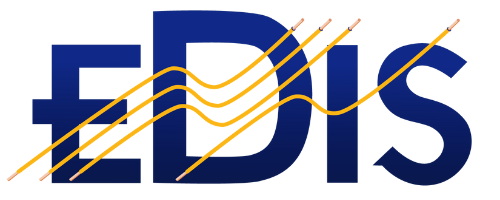BIM LEVEL 2 was introduced as a requirement for all government construction projects from April 4th 2016. This puts the responsibility on the contractor to demonstrate that they have the processes in place to meet the BIM Level 2 requirements. Theses processes need to show how you will meet the project’s requirements and how you will adhere to required standards.
EDIS is a cloud native fixed wire electrical data management system – it provides a central, rights controlled repository for creating and managing and sharing electrical information through the lifecycle of the building asset.
EDIS provides an online solution, software and processes for BIM compliance processes relating to capturing and managing fixed wire electrical information. EDSI aligns with BS7671 and provides the electrical certificates to verify and validate the new electrical installation and then shares the data in re-useable format. In this way EDIS supports the required BUM Level 2, COBie and other construction project electrical data creation, sharing and transfer requirements.
——— PRE-CONSTRUCTION
1. UNDERSTAND AND FOLLOW THE BIM PROTOCOL
BIM protocol is a addendum included in every government project contract describing and specifying the BIM requirements for the project. These requirements need to be understood as part of the project specification and deliverables.
2. CREATE A LEVEL 2-READY PROJECT PLAN
The Employer’s Information Requirements (EIR) will define any Low Voltage Electrical requirements, including the need for testing the installation and delivering the resulting as installed documents and testing results.
Your BIM Execution Plan (BEP), Master Information Delivery Plan (MIDP), and a Task Information Delivery Plan (TIDP) should include a statement on how EDIS will be used to capture and deliver the required documentation.
Referencing the EDIS and the EDIS document and record management features used to manage the sub-main, sub-circuit and earthing details, the alignment of this information with references in the electrical design schematics via suitable references.
——— DESIGN TO CONSTRUCTION
3. COLLABORATE AND CO-ORDINATE
EDIS will facilitate the store, manage and exchange information via a CDE (Common Data Environment), the CDE provides a shared workspace where everyone involved in the project will store and exchange project data. This single data point is intended to help you manage the project development process; the EDIS system will provide a structured approval process for electrical installation documents that are in progress, validated and completed .
4. SHARE DATA SECURELY
PAS 1192-5 provides security considerations for safely sharing project data, depending on the nature of the client and project. The EDIS security, providing control on who has access to information and who can change it will ensure information is being shared in a secure way. EDIS will provide controlled access to information stored in the CDE, and provide an audit trail to track and manage activity, specifically final inspection and testing documents.
5. SPEAK THE SAME LANGUAGE
All client personnel, engineers, designers contractors and managers working on a government construction project will need to know where electrical data lives, how to find it and how it references back to CAD files. The key classifier is the Distribution Board reference number, this is a unique reference numbr given to sub-mains, sub-circuits and circuits and provides a key field for locating electrical project data quickly and accurately.
6. USE COBie IN YOUR PROJECT
Construction Operations Building Information Exchange (COBie) is a specification relating to managed asset information including space and equipment. It is closely associated with building information modelling (BIM) approaches to design, construction, and management of built assets.
Conceptually it is a central spreadsheet where primarily text data can be securely stored, shared and updated throughout the construction project. Technically, it is a database that contains assets, asset attributes and the associations between assets. IN practice it may be a spreadsheet or other data store.
EDIS provide a list and relationships between of the sub-mains, sub-circuits and other electrical components required for LV electrical system testing and commissioning. EDIS’s feeds the electrical COBie requirements by providing data extracts that can be integrated into the COBie model.
——— HANDOVER
7. PASS ON THE BATON
Handing information to clients is as simple as providing and EDIS user transition, where the client users are provided with access to the EDIS system so that they can continue using and updating the information.
8. PLAN FOR A SMOOTH HANDOVER
Handover to the facility operational team that will manage and maintain the building on an ongoing basis, can immediately access and use the information to record changes, new installations and any minor works.
